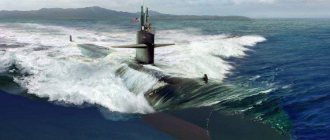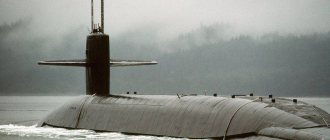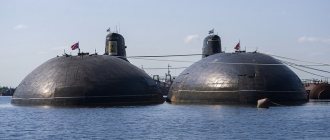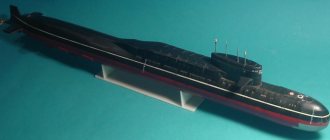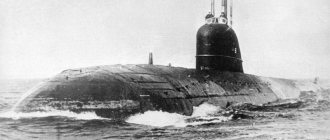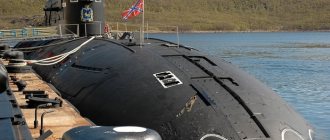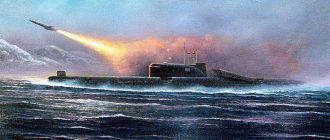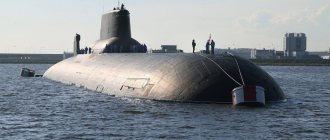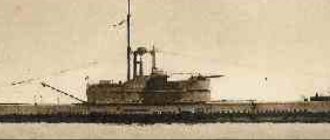Space has long been the most interesting topic for humanity. But there are no less amazing technical achievements in the world, which to some extent are spaceships from science fiction - but for different elements.
Take nuclear submarines, for example: these floating reactors reach the ocean floor, swim faster than surface ships and can remain at depth for months.
They have their own space. How did you achieve this, and where is the connection with the colonization of other planets?
Basic structure of a submarine
Any underwater vehicle is indeed very similar to a starship: a dense environment prone to turbulence at the slightest disturbance, forcing designers to use complex shapes to optimize movement.
A classic submarine with a diesel or diesel-electric unit borrows a lot from modern surface ships: there is a deck and a glass cabin and even a waterline dividing the hull into 2 parts: surface and underwater.
Such a boat most of the time - during long sea passages, “on the march” - is on the surface; Only covert execution of the task takes place underwater.
The felling was once used for its intended purpose
In addition to the outer (“light”) hull for forming the contours, the submarine has an internal (“strong”) hull, which withstands the outboard water pressure increasing with depth.
To propel diesel boats underwater, a snorkel was invented - a pipe that allows the engine to take in the air necessary for its operation above the surface of the water.
The deck has been preserved on modern nuclear submarines
It allows you to increase the duration of the underwater voyage, but its implementation requires a fairly low speed, absence of waves and a shallow diving depth.
For greater depths, batteries are used that are charged from the diesel propulsion during its operation.
Safety and life support systems
Modern submarines are equipped with air-foam, chemical and water fire extinguishing systems. Fire extinguishers and special equipment (axes, hooks, sand boxes, etc.) play an auxiliary role in emergency situations.
The air needed for breathing is produced by electrolytic plants that pass an electric current through seawater (a chemical reaction produces oxygen and hydrogen). To desalinate water needed for drinking and household needs, automatic installations with digital controllers are used.
The drainage system consists of centrifugal and piston pumps, as well as pipelines and fittings. The pumping speed of water is more than 60 cubic meters. m/h at working depth and more than 250 cubic meters. m/h on the surface.
Problems and limitations of operating diesel submarines
Appearance and cross-section of the modern diesel-electric submarine Project 677 “Lada”
This design limits the capabilities of diesel boats: it reduces speed and battery life. In addition, the hull of diesel boats does not allow reaching speeds above 50 km/h.
Likewise, the fundamental design limits the growth of the boat’s dimensions and its carrying capacity and protection. And indirectly - the depth of immersion.
Today, diesel submarines operate only in the coastal zone at a short distance from the shore, although they plied the oceans during the Second World War.
The nuclear reactor fundamentally changed the operation of submarines due to its enormous power and literally unlimited supply of energy, which led to an underwater weapons race and the emergence of two schools of shipbuilding.
Russia's first diesel submarine
After the Russo-Japanese War, the state announced its decision to develop a branch of submarine vessels and sent two projects for development. The first one is “Shark”, and the second diesel one is “Lamprey”.
The construction of one of the first diesel submarines in the world was entrusted to I. G. Bubnov, who was the chief designer of the Dolphin. The name of the submarine was given - “Lamprey”, it was developed in 1905, and from 1906 to 1909 its construction was carried out. Despite the fact that the ship was tested in 1908 and launched at the same time, the submarine was sent for revision due to the requirement to increase ballast.
Lamprey 1906
The tragic sinking of the Lamprey
On March 23, 1913, the submarine was making a test dive into water; during the tests, an emergency situation arose; water began to flow through the ventilation valve. Immediately after the rescue operation, it was discovered that all the sailors and command staff had survived, but many had suffered from chlorine poisoning. After which the ship was further used in combat operations.
"Lamprey" was a boat that took part in the First World War. She did not achieve much success, despite some attempts to attack enemy ships. And in 1915, she could have completely sunk from a ram, but due to the outstanding actions of Sergeant Major G.M. Trusov, she survived, and after repairs in 1918 she still served in the civil war in the Caspian Sea.
Russian diesel submarines had predominantly an engine that ran not only on diesel, but also on electricity, which helped them move underwater almost silently.
American and Soviet shipbuilding school
The first nuclear submarine of the Soviet Union "Leninsky Komsomol"
The appearance of a reactor on board a submarine posed three tasks for the developers: to link the capabilities of the reactor with the capabilities of the boat, to protect the crew and to come up with new applications.
Already the first nuclear submarine of the USSR K-3 “Leninsky Komsomol” received a cigar-shaped hull with a minimal upper deck and a streamlined wheelhouse resembling the fin of a sea animal.
The hull of the American Nautilus is similar to its diesel predecessors: overseas colleagues changed the external design a little later, using the operating experience of the first nuclear-powered submarine.
Against this background, a clear division of nuclear submarine development paths emerged: American and Soviet.
The first US nuclear submarine USS Nautilus
By the time the Nautilus was launched, US engineers had a nuclear reactor ready, so they built a boat around the reactor. Proven reliability allowed the use of one main power plant, supplemented by diesel units.
The units of the factories of the Soviet Union were created in a hurry, so the K-3 was built with duplication of the power plant. The simultaneous design of the units and the vessel itself made it possible to “more elegantly” accommodate the crew and equipment.
This later led to a fundamental difference: US nuclear submarines always have one reactor. Russian and Soviet ones were built with either one or two reactors, depending on the size of the vessel and its purpose.
How are modern nuclear submarines divided and what tasks do they perform?
Project 941 Akula submarines were considered as underwater transports
Traditionally, nuclear submarines are divided into 3 classes and a general category of special ships:
1. Multi-purpose boats (torpedo boats) - designed to destroy enemy ships and submarines.
2. Boats with cruise missiles - Russian ones are “sharpened” for destroying aircraft carriers, American ones - for strategic and tactical non-nuclear strikes on ground targets.
3. Strategic missile carriers - designed for secretive autonomous navigation with the ability to deliver a nuclear strike; they are deterrent forces.
4. Special vessels - designed from scratch or converted from combat vessels to perform seabed exploration, cartography, electronic warfare/communications/reconnaissance tasks, and laying underwater communications.
Project 667BDR strategic missile submarine "Kalmar"
The development of the fleet largely forced the unification of the first ones under the name “multi-purpose nuclear submarines” due to the unification of weapons. Some huge high-speed “secret vessels” with great diving depths are still in service.
Nuclear submarines are divided according to their purpose:
· SSBN (Strategic Missile Submarine Cruiser). As part of the nuclear triad, these submarines carry ballistic missiles with nuclear warheads. The main targets of such ships are military bases and enemy cities. The SSBN includes the new Russian nuclear submarine 955 Borei. In America, this type of submarine is called SSBN (Ship Submarine Ballistic Nuclear): this includes the most powerful of these submarines - the Ohio-class boat. To accommodate the entire lethal arsenal on board, SSBNs are designed taking into account the requirements of a large internal volume. Their length often exceeds 170 m - this is noticeably longer than the length of multi-purpose submarines.
LARK K-186 "Omsk" pr.949A OSCAR-II with open covers of launchers of the Granit missile system. The boats of the project in the Navy have the unofficial name “Baton” - for the shape of the hull and impressive size.
· PLAT (nuclear torpedo submarine). Such boats are also called multi-purpose. Their purpose: the destruction of ships, other submarines, tactical targets on the ground and the collection of intelligence data. They are smaller than SSBNs and have better speed and mobility. PLATs can use torpedoes or high-precision cruise missiles. Such nuclear submarines include the American Los Angeles or the Soviet/Russian MPLATRK Project 971 Shchuka-B.
Project 941 Akula submarine
The American Seawolf is considered the most advanced multi-purpose nuclear submarine. Its main feature is the highest level of stealth and deadly weapons on board. One such submarine carries up to 50 Harpoon or Tomahawk missiles. There are also torpedoes. Due to the high cost, the US Navy received only three of these submarines.
Project 941 Akula submarine
· SSGN (nuclear submarine with cruise missiles). This is the smallest group of modern nuclear submarines. This includes the Russian 949A Antey and some American Ohio missiles converted into cruise missile carriers. The SSGN concept has something in common with multi-purpose nuclear submarines. Submarines of the SSGN type, however, are larger - they are large floating underwater platforms with high-precision weapons. In the Soviet/Russian navy these boats are also called “aircraft carrier killers”.
The evolution of nuclear submarines
Lyra project submarine
The development of nuclear submarines gave humanity 5 conventional generations, connected by common design features and logic of application:
1. The first generation became the founder of nuclear submarines, but was quite numerous and remained in service for a long time. The main common feature was heritability with diesel-electric predecessors.
The boats were rather experimental in nature, often intended for “combat testing” of design ideas.
2. The second generation was a direct development of the previous one with minimal changes and begins its countdown in 1967.
Late-built nuclear submarines received a “fish-shaped” hull geometry (Project 705 “Lira” in the USSR) and complex automated control systems (“Accord” on the same boat), which became the first prototype of a modern control center for complex systems in the form of a single remote control.
Project 661 nuclear submarine "Anchar"
The founder of the “aircraft carrier hunters” K-162/222 “Goldfish” of Project 661 “Anchar” with an all-titanium hull became a serious application for the USSR nuclear submarine. The submarine reached a still unbroken speed record of 44.74 knots (80.4 km/h).
3. The third generation appeared in the early eighties and is characterized primarily by a significantly increased displacement, increased autonomy, improved living conditions for the crew, as well as the unification of submarines and their classes.
American boats of the Ohio and Los Angeles type received reactors that operate without recharging for up to 11 years and do not require major repairs throughout their entire life cycle - up to 30 years.
The richest period of shipbuilding: most of the boats are still in service. Many of them are unique, for example the notorious Project 685 “Plavnik” record holder K-278 “Komsomolets” with two titanium hulls and a diving depth of up to 1000 meters.
US Navy missile-carrying cruiser Ohio
4. The fourth generation is currently the most modern, starting its history in the early nineties. In the USA it is represented only by multi-purpose types.
These devices are united by the use of water-jet propulsion (Seawolf, project 955), sound-absorbing coatings of a new type, new materials (composite), and long-life reactors.
After a number of disasters with previous generation submarines, the projects received their own autonomous escape capsules and a completely isolated reactor.
The armament increased and was unified: for example, American boats learned to store up to 50 cruise missiles of the main types used by the US Navy.
5. The promising fifth generation exists only on paper, but it is expected that it will include mainly multi-purpose submarines.
The main change will be a nuclear reactor with an energy reserve for the entire life cycle of the submarine (in the USA it is being implemented in fourth-generation boats), a completely composite hull, as well as unified weapons.
The same launchers will use both ballistic and tactical cruise missiles, as well as other non-nuclear weapons to perform a wide range of tasks.
Table 5
* Improved modification, the lead nuclear submarine of the third subseries.
** According to other sources - 2×30000 hp. In relation to nuclear submarines (sometimes also to nuclear submarines), the rather conventional but widespread concept of “generation” is used. The signs by which nuclear submarines are classified as belonging to a particular generation are: proximity in time of creation, commonality of technical solutions incorporated in the projects, the same type of power plants and other equipment for general ship purposes, the same hull material, etc. One generation can be classified as nuclear submarines for various purposes and even several successive series. The transition from one series of submarines to another, and even more so the transition from generation to generation, is preceded by comprehensive research in order to justify the selection of optimal combinations of the main tactical and technical characteristics of new nuclear submarines.
Rice. 11. The newest Russian multi-purpose nuclear submarine of the Bars type (project 971)
The relevance of this kind of research has especially increased with the advent of the possibility (thanks to the development of technology) of creating nuclear submarines that differ significantly in speed, immersion depth, stealth indicators, displacement, armament composition, etc. The implementation of these studies sometimes continues for several years and includes the development and military-economic assessment for a wide range of alternative nuclear submarine options - from an improved modification of a serially built nuclear submarine to a variant that is a synthesis of fundamentally new technical solutions in the field of architecture, energy, weapons, hull materials, etc.
As a rule, these studies are not limited only to the design of nuclear submarine variants, but also include entire programs of research and development work in hydrodynamics, strength, hydroacoustics and other areas, and in some cases, discussed above, also the creation of special experimental nuclear submarines.
In countries that build nuclear submarines most intensively, three or four generations of these ships have been created. For example, in the United States, among multi-purpose nuclear submarines, generation 1 usually includes nuclear submarines of the Skate and Skipjack types, generation 2 - Thresher and Sturgeon, generation 3 - LosAngeles. The Seawolf nuclear submarine is considered as a representative of a new, fourth generation of US Navy nuclear submarines. Among the missile carriers, the first generation includes the boats “George Washington” and “Ethan Allen”, the second - “Lafayette” and “Benjamin Franklin”, the third - “Ohio”.
Rice. 12. Modern Russian nuclear submarine missile carrier "Akula" type (project 941)
In total, by the end of the 90s, about 500 nuclear submarines were built in the world (including those disabled due to obsolescence and lost). The number of nuclear submarines by year in the navies and navies of different countries is given in table. 6.
General structure of a modern nuclear submarine
The missile-carrying nuclear submarine cruiser of Project 941 "Shark" in the context of
the average submarine plying the world's oceans right now can be described by a single conceptual scheme. Individual units and lines may change, but the idea itself has remained unchanged since the seventies.
Most Russian submarines use two hulls (separate capsules in general) - an internal one made of soft and durable titanium and an external one made of low-magnetic steel. American ones use one multilayer hull, separated by bulkheads. Just like 50 years ago.
Between the hulls (for US nuclear submarines - in the total volume) there are water tanks. When they are filled, the boat lowers, pumping raises the vessel to the surface. The tanks can be filled simultaneously or one at a time.
In addition to the main ones, there are so-called trim tanks: they are filled to level the boat after loading and when the cargo moves. This system works all the time, even underwater when moving horizontally.
US Navy Virginia-class multipurpose nuclear submarine
There are also boats with a mixed hull (when a light hull only partially covers the main one) and multi-hulls (several strong hulls inside a light one).
The colossal nuclear submarines of Project 941 "Shark", created on the principle of a catamaran, carry five strong hulls inside a light hull, two of which are the main ones. Titanium alloys were used to make durable cases, and steel alloys were used for lightweight ones.
The bulkheads between the compartments are designed for a pressure of 10 atmospheres and are connected by hatches that can be sealed if necessary. Not all domestic nuclear submarines have so many compartments.
For reference: the Project 971 multi-purpose nuclear submarine, for example, is divided into six compartments, and the new Project 955 missile carrier is divided into eight.
Compartments of a nuclear submarine and their purpose
Cross-section of Project 941 multi-purpose nuclear submarine
The traditional layout includes from 5 to 8 compartments (duplicated on Project 941 boats) with their purpose and specific configuration, down to the materials used.
1. The first compartment carries torpedo tubes and the torpedoes themselves on several decks, therefore, depending on the type and degree of automation, the boat may be uninhabited and located immediately behind the light hull.
2. The second compartment is most often used to accommodate radio equipment: there is a central control panel, hydroacoustic system consoles, microclimate regulators and satellite navigation equipment.
It is in the second compartment that the wheelhouse is located, used to place antennas and periscopes. Its main purpose is observation from an underwater position.
3. The third compartment on modern Russian submarines of projects 949A and 955 is used as a radio communications compartment. Many early types combine this with a central control compartment.
4. The fourth compartment (also the third on a number of boats of 3-4 generations) is residential: crew cabins, rest rooms, and a galley are located here. The main part of the crew, not involved in work at the moment, spends time in it.
Soviet and Russian nuclear submarines between this and the next compartment carry additional compartments for decontamination of crew members: cleaning the clothes of crew members who worked in the compartment with reactors.
Missile silos of attack submarines
5. The fifth (sixth on Russian nuclear submarines) compartments house the power plant. Depending on the type of reactor, diesel generators can be located in the same room or in a separate room.
Fifth-generation submarines, as well as the American Seawolf nuclear submarines, use a sealed reactor capsule that can be completely isolated from the rest of the boat.
The most modern submarines have compartments 7 and 8 , where the reactor control center and turbine unit with batteries are located. This arrangement eliminates contact with the reactor.
Also, in the last compartments there can be an autonomous capsule for rescuing the crew, created like a descent spacecraft.
table 2
The fusion of nuclear energy and intercontinental-range ballistic missiles gave submarines, in addition to their initial advantage (stealth), a fundamentally new quality - the ability to hit targets deep in enemy territory.
This has turned nuclear submarines into the most important component of strategic weapons, occupying perhaps the main place in the strategic triad due to its mobility and high survivability. At the end of the 60s, the USSR created nuclear submarines of a fundamentally new type - multi-missile submarines - carriers of missile launchers with underwater launch. The appearance and subsequent development of these nuclear submarines, which had no analogues in foreign navies(3), was a real counterweight to the most powerful surface combatants - attack aircraft carriers, including those with nuclear power plants.
Rice. 10. Nuclear submarine missile carrier (project 667A)
At the turn of the 60s, in addition to rocketization, another important direction in the development of nuclear submarines arose - increasing their secrecy from detection, primarily by other submarines, and improving the means of illuminating the underwater environment to outstrip the enemy in detection.
Due to the characteristics of the environment in which submarines operate, the determining factors in the problem of stealth and detection are the noise reduction of submarines and the range of the hydroacoustic equipment installed on them. It was the improvement of these qualities that most strongly influenced the formation of the technical appearance that modern nuclear submarines acquired.
In the interests of solving problems arising in these areas, many countries have launched research and development programs of unprecedented scope, including the development of new low-noise mechanisms and propulsors, testing of serial nuclear submarines under special programs, re-equipment of built nuclear submarines with the introduction of new technical solutions on them and finally, the creation of nuclear submarines with power plants of a fundamentally new type. The latter includes, in particular, the American nuclear submarine Tillibee, commissioned in 1960. This nuclear submarine was distinguished by a set of measures aimed at reducing noise and increasing the efficiency of sonar weapons. Instead of the main steam turbine with a gearbox, used as an engine on nuclear submarines being serially built at that time, the Tullibee was implemented with a full electric propulsion scheme - a special propeller electric motor and turbogenerators of appropriate power were installed. In addition, for the first time, a hydroacoustic complex with a spherical bow antenna of increased dimensions (4) was used for a nuclear submarine, and in connection with this, a new arrangement of torpedo tubes was used: closer to the middle of the submarine’s length and at an angle of 10-12° to its center plane.
When designing the Tillibee, it was planned that it would become the lead in a series of new type of nuclear submarines, specifically designed for anti-submarine operations. However, these intentions were not realized, although many of the technical means and solutions used and tested on it (hydroacoustic complex, layout of torpedo tubes, etc.) were immediately extended to the Thresher-class serial nuclear submarines being built in the 60s.
Following the "Tillibee", two more experimental nuclear submarines were built to test new technical solutions to increase acoustic stealth: in 1967, the nuclear submarine "Jack" (5) with a gearless (direct-acting) turbine installation and coaxial propellers in the opposite direction of rotation (like those used on torpedoes) and in 1969, the Narwhal nuclear submarine, equipped with a new type of nuclear reactor with an increased level of natural circulation of the primary coolant. This reactor was expected to have a reduced level of noise emissions due to a reduction in the power of the primary circuit circulation pumps. The first of these solutions was not developed, but as for the new type of reactor, the results obtained were used in the development of reactors for serial nuclear submarines in subsequent years of construction.
In the 70s, American specialists again returned to the idea of using full electric propulsion on nuclear submarines. In 1974, the construction of the nuclear submarine Glenard P. Lipscomb with a turboelectric power plant consisting of turbogenerators and electric motors was completed (6). However, this nuclear submarine was not accepted for mass production. The characteristics of the nuclear submarines "Tillibee" and "Glenard P. Lipscomb" are given in table. 3.
The refusal to “replicate” nuclear submarines with full electric propulsion suggests that the gain in noise reduction, even if it occurred on nuclear submarines of this type, did not compensate for the deterioration of other characteristics associated with the introduction of electric propulsion, primarily due to the impossibility of creating electric motors of the required power and acceptable dimensions and, as a consequence, a decrease in the speed of full underwater travel compared to nuclear submarines with turbo-drive units that were built at a similar date.
Nuclear submarine power plant: reactor, turbine and electric motor
Basic operating principle of a nuclear reactor
The main unit that distinguishes a nuclear boat from a diesel boat is the reactor. Depending on its type, the type of drive may vary.
In a typical nuclear reactor engine, cooled water is pressurized into the reactor vessel containing the nuclear fuel. The heated water leaves the reactor, turns into steam and rotates the turbine blades.
The turbine shaft is connected to the electric motor shaft through a gearbox for more efficient conversion of energy into electricity.
In turn, the electric motor shaft is connected to the propeller shaft using a clutch mechanism. At the same time, part of the electricity is stored in on-board batteries.
Nuclear submarine working compartment
The conversion of the energy of steam molecules into the kinetic energy of the blades leads to the condensation of steam back into water, which again enters the reactor.
Against this background, the number of nuclear submarine accidents looks interesting. In total, 8 submarines sank in the history of the nuclear fleet: 4 Soviet, 2 Russian, 2 American. Only one, USS Thresher (SSN-593) due to hull damage.
The infamous Kursk of Project 949A Antey became the most famous disaster of the Russian fleet and perhaps the only accident due to weapons. Others sank due to direct or indirect problems with the propulsion system.
Submarine weapons: nuclear and non-nuclear
Underwater launch of a Tomahawk cruise missile
Initially, nuclear submarines were designed as carriers of strategic nuclear weapons: nuclear submarines were supposed to quietly break through the defenses of a potential enemy and deliver a surprise strike.
The ballistic missiles of the first generation nuclear submarines carried a monoblock part and did not have a long range and required a surface launch in relatively calm water (in the absence of cross winds).
US boats carried 16 Polaris carriers of modifications A1, A2, A3, Poseidon C3, Trident 1 C4 with a range from 2200 km for A1 to 7400 km for C4. The nuclear submarines of the Soviet Union carried 3 R-13 missiles, later replaced by the R-21 with a range of only 650 km and 1420 km.
Ballistic missile launchers
The second generation of nuclear submarines received missiles with multiple warheads (with 3 or 7 blocks) ranging from 8 to 16 in both the USSR and the USA. Early Soviet missiles of this generation R-29 received a firing range of 7800 km, later copies of the R-29R - 9000 km/6500 km (monoblock/multiple warhead).
The third and fourth generations received from 16 (project 955) to 24 ballistic missiles (project 941 “Akula”, “Ohio”) R-29RMU2 “Sineva”, R-30 “Bulava-30”, UGM-133A “Trident II” with range up to 9-11 thousand km.
In addition to ballistic missiles, missile carriers carry 4-6 torpedo tubes of 533 or 650 mm caliber for self-defense and launching specialized means: acoustic buoys, mines, special equipment.
Diagram of an underwater launch of a ballistic missile from an Ohio-class submarine
Non-nuclear (conventionally, many guided munitions have or had a developed nuclear warhead) armament of nuclear boats from the early stages was represented by both medium and large caliber torpedoes and cruise missiles.
"Amethyst" and "Malachite" in the mines became the first weapons launched from under water. Today they are being replaced by “Harpoon”, “Tomahawk” (“Sifwolf”) and “Caliber”, “Oniks”, “Zircon” (Russian boats of Project 855 “Ash”).
Interesting: the famous Russian low-flying hypersonic missiles were created specifically for submarines and were initially intended to destroy ships.
Launch of the UGM-133 Trident-II ballistic missile
Starting from the fourth generation, nuclear submarine hunters were equipped with universal launchers with drum “magazines” for launching torpedoes, cruise missiles, as well as surface-to-surface missiles.
They are being replaced by standardized options for simplified launching from torpedo tubes: during such a launch, the rocket engine is switched on far from the nuclear submarine, and the first stage of launch occurs, like a torpedo, with compressed air.
Table 1
*Equal to the sum of the surface displacement and the mass of water in completely filled main ballast tanks.
**For American nuclear submarines (hereinafter) the test depth, which is close in meaning to the maximum. Rice. 6. The first domestic serial nuclear submarine (project 627 A)
circuit of a nuclear reactor. Along with water, which has a high degree of purification, which was used in the reactors of the first nuclear submarines, an attempt was made to use for this purpose a metal or an alloy of metals with a relatively low melting point (sodium, etc.). The designers saw the advantage of such a coolant, first of all, in the ability to reduce the pressure in the primary circuit, increase the temperature of the coolant and, in general, gain a gain in the dimensions of the reactor, which is extremely important in the conditions of its use on submarines.
Rice. 7. The first American nuclear submarine “Nautilus”
This idea was implemented on the second American nuclear submarine after Nautilus, Seawolf, built in 1957. It used an S2G reactor with a liquid metal (sodium) coolant. However, in practice, the advantages of the liquid metal coolant turned out to be not as significant as expected, but in terms of reliability and
Rice. 8. The first domestic nuclear submarine “Leninsky Komsomol” (project 627)
Due to the complexity of operation, this type of reactor was significantly inferior to a water-cooled reactor (with pressurized water in the primary circuit).
Already in 1960, due to a number of problems that emerged during operation, the liquid-metal coolant reactor on the Seawolf nuclear submarine was replaced by the S2WA pressurized water reactor, which was an improved modification of the NautiIus nuclear submarine reactor.
In 1963, the USSR introduced the Project 645 nuclear submarine into the fleet, also equipped with a reactor with a liquid metal coolant, which used an alloy of lead and bismuth. In the first years after construction, this nuclear submarine was successfully operated. However, it did not show any decisive advantages over nuclear submarines with pressurized water reactors being built in parallel. However, the operation of a liquid-metal cooled reactor, especially its basic maintenance, caused certain difficulties. Serial construction of this type of nuclear submarine was not carried out; it remained a single copy and was part of the fleet until 1968.
Along with the introduction of nuclear power plants and equipment directly related to them on submarines, their other elements also changed. The first American nuclear submarine, although larger in size than the submarine, differed little from them in appearance: it had a stem bow (1) and a developed superstructure with an extended flat deck. The hull shape of the first domestic nuclear submarine already had a number of characteristic differences from the diesel submarine. In particular, its nasal extremity was given contours that were well streamlined in the underwater position, having a semi-elliptical outline in plan and cross sections close to circular. The fencing of retractable devices (2) (periscopes, RDP devices, antennas, etc.), as well as the hatch and bridge shafts, were made in the form of a streamlined body like a limousine, hence the name “limousine” shape, which later became traditional for fencing in many types of domestic nuclear submarine
To make maximum use of all the opportunities to improve the tactical and technical characteristics caused by the use of nuclear power plants, research was launched to optimize the hull shape, architecture and design, controllability when moving underwater at high speeds, automation of control in these modes, navigation support and habitability in conditions of prolonged scuba diving without surfacing.
A number of issues were resolved using specially built experimental and experimental non-nuclear and nuclear submarines. In particular, in solving the problems of controllability and propulsion of nuclear submarines, an important role was played by the experimental submarine “Albacore”, built in the USA in 1953, which had a hull shape close to optimal in terms of minimizing water resistance when moving in a submerged position (the ratio of length to width was about 7.4). Below are the characteristics of the Albacore diesel submarine:
Dimensions, m: length………………………………………………………………………………….62.2 width……………………… ………………………………………………………8.4 Displacement, t: surface…………………………………………………… ……………………..1500 underwater……………………………………………………………………………………………….1850 Power plant: power of diesel generators, l. s…………………………………..1700 electric motor power *, l. s……………………….about 15000 number of propeller shafts…………………………………………………………….1 Full submerged speed, knots……… ……………………………….33 Test immersion depth, m………………………………………………………..185 Crew, persons…………………………… …………………………………………………………………….52
*With silver zinc battery.
This submarine was refitted several times and was used for a long time to test propellers (including coaxial counter-rotating ones), controls when moving at high speeds, new types of propellers and solving other problems.
The introduction of nuclear power plants on submarines coincided with the development of a number of fundamentally new types of weapons: cruise missiles (CR) for firing along the coast and for hitting sea targets, and later - ballistic missiles (BR), long-range radar detection of air targets.
Advances in the creation of land- and sea-based ballistic missiles have led to a revision of the role and place of both land and sea weapons systems, which is reflected in the development of the type of nuclear submarines. In particular, missile launchers intended for shooting along the shore gradually lost their importance. As a result, the United States limited itself to building only one nuclear submarine, the Halibut, and two diesel submarines, Grayback and Growler, with the Regulus cruise missile, and the nuclear submarines with the cruise missile built in the USSR to hit coastal targets were subsequently converted into nuclear submarines with only torpedo launchers. weapons.
A single copy of the Triton radar patrol nuclear submarine built in the United States during these years, designed for long-range detection of air targets using especially powerful radar stations, remains in one copy. This submarine is also notable for the fact that, of all the American nuclear submarines, it was the only one that had two reactors (all other US nuclear submarines are single-reactor).
The world's first launch of a ballistic missile from a submarine was carried out in the USSR in September 1955. The R-11 FM missile was launched from a converted submarine from the surface position. From the same submarine, five years later, the first launch of a ballistic missile in the USSR from an underwater position was carried out.
Since the late 50s, the process of introducing ballistic missiles on submarines began. First, a small-missile nuclear submarine was created (the dimensions of the first domestic liquid-fueled naval ballistic missiles did not allow the creation of a multi-missile nuclear submarine at once). The first domestic nuclear submarine with three ballistic missiles launching from the surface was put into operation in 1960 (by this time several domestic submarines with ballistic missiles had been built).
In the United States, based on the successes achieved in the field of naval ballistic missiles, they immediately went to create a multi-missile nuclear submarine with support for launching missiles from an underwater position. This was facilitated by the Polaris solid fuel ballistic missile system, which was successfully implemented in those years. Moreover, to shorten the construction period of the first missile carrier, the hull of a serial nuclear submarine, which was under construction at that time, was used
Rice. 9. George Washington-class nuclear-powered missile submarine
with torpedo armament of the “Skipjack” type. This missile carrier, named "George Washington", entered service in December 1959. The first domestic multi-missile nuclear submarine (Project 667A) with 16 ballistic missiles launched from a submerged position entered service in 1967. In the UK, the first nuclear-powered missile carrier, created in a wide range using American experience, it was commissioned in 1968, in France - in 1974. The characteristics of the first nuclear submarines with ballistic missiles are given in Table. 2
In the years following the creation of the first submarines, there was a continuous improvement of this new type of naval weapons: an increase in the flight range of naval ballistic missiles to intercontinental, an increase in the rate of fire of missiles up to salvo, the adoption of ballistic missiles with multiple warheads (MIRVs) containing consisting of several warheads, each of which can be aimed at its own target, increasing the ammunition load of missiles on some types of missile carriers to 20-24.
Operation of nuclear submarines
Dry dock for servicing Ohio-class nuclear submarines
The emergence of nuclear submarines has forced us to reconsider the use and repair of these types of vessels: their underwater part has dimensions that are unsuitable for conventional ports, and the reactors are dangerous.
Considering that most of the tasks involve long-term covert use off the coast of a potential enemy, the campaign must also begin in a secret place - otherwise the boats can be tracked from the beginning of the journey.
Similar reasoning, the need to protect nuclear submarines from a possible enemy strike, the need to protect the environment from possible problems with reactors/weapons, led to the emergence of unique closed bases the size of a metropolis.
Scheme of the underground nuclear submarine base in Balaklava Bay
The first appeared in Balaklava Bay, occupying a colossal area with separate rooms connected by tunnels and canals: missiles separately, warheads separately, boats separately.
Repairs are also in special zones, since the 1st-3rd generation of boats required not only a replacement of fuel, but also a replacement of the reactor core. Similar complexes were created above water for each ocean fleet: in Severodvinsk, in the Arctic, in Chazhma Bay.
The US nuclear submarine was luckier: the Kings Bay naval base housed all the necessary infrastructure, including training centers and modernization plants, in one place with weather conditions that eliminated problems during repair or loading work.
Russian submarine base
Specialized bases are used only for long-term shutdowns of nuclear submarines, repairs and loading of nuclear materials. The rest of the time, nuclear submarines are supplied from floating berths (USSR), supply ships (Russia and the USA), remaining almost all the time on the open sea.
Modern multi-purpose boats often use regular naval ports for short deployments, leaving for special bases only when necessary - the likelihood of radioactive contamination of the environment during their operation is low.
What does the autonomy of a nuclear submarine depend on?
Nuclear submarines and escort vessels
The advent of a nuclear reactor and an increase in the volume of the submarine hull after the appearance of a nuclear reactor on board made it possible to increase the payload by a factor of 10 compared with diesel submarines.
At the same time, so does the duration of autonomous travel. It is believed that the duration of an autonomous voyage, as a single voyage of a nuclear submarine is called, can reach six months: the task of patrolling the shores of a potential enemy takes approximately that long.
Moreover, many of the modern nuclear submarines are capable of staying under water for up to half of this time. And for the entire period, do not replenish supplies either from the shore or from support vessels.
However, the average voyage of the submarine fleet of all states is about 2-3 months.
In the recreation area of the nuclear submarine of project 941
Of these, at least a quarter of the time is spent on the surface, and at least half is spent in direct proximity to fire support ships and supply vessels, which are combined with nuclear submarines into a single combat (patrol/training) group.
The duration of the trip is limited based on operating experience, on which the supply of food, filters for fresh water and clean air is based.
The fact is that the main deterrent to long-term autonomous voyages of nuclear submarines is psychological. It is too difficult for a person to be in a confined space with a narrow group for a long time.
In addition, the navigation of a nuclear submarine requires constant monitoring and a lot of standard work; there is no time to relax. Otherwise, there would be ships that remain under water for years.
Stories of Russian submarine forces
Throughout its life, Russia has been a military power, so it is not surprising that the government decided to keep up with the whole world and enlisted the first submarine vessel in its fleet in 1903, which laid the foundation for the submarine fleet.
First submarine projects
“Dolphin” is considered the first full-fledged submarine of the largest country in the world; before it there was also “Peter Koshka”, but it was very small and served only as a small vessel for covert penetration into enemy territory and reconnaissance landings. In 1904, the first Russian submarine was completed, and in May of this year it was already at sea. She underwent all checks in the Baltic Sea, after which she was transported by rail to Vladivostok, where she was called up for hostilities between Japan and Russia.
Peter Koshka 1901
Lieutenant M.N. Beklemishev was a senior assistant in electrical engineering, and in 1901 he was sent on a business trip to the United States, where he was present at the first test dive of the Fulton submarine, and he was also allowed to inspect a foreign ship. After this trip, the lieutenant stated that the domestic ship was not inferior in quality to the American ones, and several design solutions were completely unique. The trip also gave Beklemishev guidance for gathering a team for the Dolphin; Russia’s first submarine consisted of a crew of 10 people, including one commander and his assistant, 4 mine specialists, as well as two helmsmen and drivers. Each submarine employee was a volunteer, from whom the chief mate selected.
All technical characteristics of the submarine of the Russian Empire, of course, were not at the level of modern vessels:
- Surface/submerged speed: 9/6 knots
- Dive level: 50 meters
- Displacement surface/underwater: 113/up to 135 tons
- Length/width: 20/3.66 meters
- It was armed with two torpedoes of 1898
At first, the designers wanted to install a diesel engine, but then the commission decided to opt for gasoline.
During the war, the “Dolphin” sailed for 17 days across the expanses of the sea, and also went on a campaign for 8 days. In 1916 he was sent north again to Murmansk, and the following year, in August, he was expelled from the fleet, and in 1920 he was scrapped.
The main merit of the ship was not military at all, but the fact that it gave a start to the entire underwater shipbuilding industry and served as a prototype for future submarines.
What does the future hold for nuclear submarines?
Nuclear research submarine "Losharik"
The most modern Russian submarines of the Husky class are still being designed, but it is already clear that they inherit many of the ideas implemented in the fourth generation ships operated by the United States:
- modular reactor, made in a separate compartment that does not require maintenance;
- fuel cell capacity for 20-30 years, that is, for the entire operation;
- an autonomous escape capsule for all crew members.
It is likely that the organization of the space of such boats will be created with an eye on the Losharik project: a unique nuclear submarine for exploring the ocean floor, whose hull consists of individual spherical modules, which is why it evokes associations with the Soviet film of the same name.
Compartment of the Project 941 Akula nuclear submarine
It is already clear today that the duplication of reactor systems will remain, and the main propulsion will be a water jet, controlled by a secondary electric motor during main operation, and directly by the reactor turbine during the high-speed march.
We should also expect fully automated control systems that will allow the crew to be concentrated in one most protected module without the need for constant transitions to work compartments.
What would such a nuclear submarine look like? We'll see. But it will have a lot in common with the spaceships that will fly after some time.
PS The World Ocean is no less dangerous a world than space. And only nuclear submarines bring us closer to future discoveries.
(
217 votes, overall rating: 4.83 out of 5)
